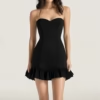Wholesale distribution plays a pivotal role in the fashion industry, acting as an intermediary that connects manufacturers with retailers. This essential function ensures that the latest collections and trends reach consumers efficiently. In this blog post, we’ll delve into the dynamics of wholesale distribution, its significance, and how fashion brands can effectively leverage it for growth.
What is Wholesale Distribution?
Wholesale distribution involves purchasing large quantities of products from manufacturers and reselling them to retailers in smaller amounts. According to NetSuite, wholesalers buy products in bulk at discounted rates and distribute them to retailers and e-commerce sellers. This model is crucial in simplifying the supply chain, reducing costs, and ensuring that products are available to a broad audience.
Key Features of Wholesale Distribution:
- Bulk Purchasing: Wholesalers buy products in large quantities, often at lower prices.
- Inventory Management: They store and manage inventory, reducing the burden on manufacturers and retailers.
- Logistics: Wholesalers handle shipping and delivery, ensuring timely distribution.
For a deeper dive into wholesale distribution, check out this guide by TradeGecko.
The Role of Wholesalers in the Fashion Industry
Wholesalers serve as the bridge between fashion brands and retailers. They manage the logistics, storage, and distribution of fashion products, including apparel, accessories, and more. According to TrueCommerce, fashion wholesalers are essential in connecting niche apparel brands to big global retailers. This connection helps brands expand their market reach and streamline their operations.
Why Wholesalers Matter:
- Market Expansion: Wholesalers help brands reach retailers in different regions and countries.
- Efficiency: They simplify the supply chain, allowing brands to focus on design and production.
- Cost Savings: By buying in bulk, wholesalers reduce costs for manufacturers and retailers.
Distribution Channels in the Fashion Industry
Fashion brands have various distribution channels available to get their products into the hands of consumers. As highlighted by MerchFarm, these channels can include:
- Sales Representation: Utilizing sales agents to promote and sell products.
- Showrooms: Physical spaces where collections are displayed for retailers.
- Trade Shows: Events where brands can showcase their products to a broad audience.
- Internet Stores: Online platforms to reach a global market.
- Brick and Mortar Stores: Traditional retail spaces.
- Direct Sales: Selling directly to consumers without intermediaries.
Each channel has advantages, and brands often combine to maximize their reach. For example, a brand might sell through its website while partnering with wholesalers to reach brick-and-mortar stores.
Advantages of Wholesale Distribution
Wholesale distribution offers several advantages that can be significantly beneficial for fashion brands. According to an article by Retailboss, some key benefits include:
- Cost Savings: Buying in bulk reduces the cost per unit.
- Wide Range of Products: Access to diverse products increases the offering to retailers.
- Building Relationships: Stronger relationships with suppliers and retailers.
- Scalability: Ability to grow and handle larger orders.
- Direct Customer Interaction: Insights from retailers about consumer preferences.
The Wholesale Fashion Ecosystem
The wholesale fashion ecosystem is a network of interconnected roles, as detailed by NetSuite. It includes:
- Brands: The creative heart that designs and manufactures collections.
- Distributors: Intermediaries that manage the movement of goods from manufacturers to retailers.
- Suppliers: Provide the raw materials for product creation.
- Retailers and Buyers: The end point of the chain, selling products to consumers.
- Showrooms and Agents: Facilitate the display and promotion of collections.
Leveraging Tradeshows for Growth
Tradeshows are invaluable for establishing connections and showcasing products. These fashion tradeshow events are essential for networking and staying abreast of industry trends. Brands can maximize tradeshow success by:
- Preparing Thoroughly: Set clear objectives and develop a compelling narrative.
- Investing in Booth Design: Create an attractive and engaging booth to draw visitors.
- Engaging Strategically: Interact with visitors and follow up promptly after the event.
- Promoting Your Presence: Use social media, email marketing, and other channels to announce your participation.
To keep up with upcoming fashion tradeshows, check out Retail Connects by Retailboss.
Embracing Digital Transformation
The digital shift has transformed wholesale distribution, offering new channels and greater market access. Digital prospecting involves online tools to identify, engage, and convert potential leads. This includes:
- Creating a Strong Online Presence: Develop a professional website and active social media profiles.
- Utilizing Analytics: Use data to understand customer behavior and optimize marketing strategies.
- Leveraging Virtual Showrooms: Showcase your collections online to reach a global audience.
For more on digital transformation in wholesale, explore McKinsey’s Insights.
Register for Stylebuy Today!
Take the next step in enhancing your wholesale strategy with Stylebuy. Connect with us to explore comprehensive solutions tailored to your brand’s unique needs.
Related



















































